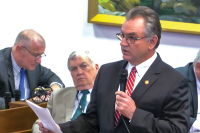Joint venture paying off for hospital group
The hospitals in Haywood, Jackson and Swain Counties can boost their bottom line by $15 million a year under their new joint venture, according to a major analysis of hospital operations conducted over the past six months.
Saving money was one of the original goals when Haywood Regional Medical Center and WestCare joined forces at the beginning of the year to create a new entity called MedWest. Both were hovering dangerously close to the tipping point between losing money and barely breaking even each year — a common plight for small hospitals in the country today.
Typically, when two companies merge, workers performing duplicate roles lose their jobs when departments are consolidated.
So far, that hasn’t happened with MedWest, and CEO Mike Poore says it isn’t on the horizon.
“We don’t predict there will be any staff layoffs,” Poore said.
Instead, $15 million can be saved by implementing a long list of changes in operations — from overhauling how patients are billed to harder-nosed negotiating when buying supplies.
Related Items
The recommendations are coming from Carolinas HealthCare System, a network of 32 hospitals based in Charlotte that now includes MedWest. MedWest entered a long-term management contract with Carolinas HealthCare System at the beginning of the year, coinciding with the joint venture.
Carolinas’ first step in its management role over MedWest has been to assess the hospitals from top to bottom.
“There were more than 60 of these people from Carolinas that came in and reviewed almost all aspects of our organization,” Poore said. “It is great to have this kind of depth and breadth of experience.”
For example, the analysis found MedWest charges less for some services compared to other hospitals, so those fees will be raised. The frustrating nature of medical billing — the dozens of insurance plans, the myriad charges racked up during a single hospital visit, the complicated codes that determine reimbursement — approaches an art form.
“It is very difficult as a standalone hospital to have all the expertise to do it correctly,” Poore said.
It’s one of the areas where MedWest benefits by being under the umbrella of Carolinas HealthCare System.
MedWest can also realize economies of scale when purchasing. It spends approximately $180 million a year on products and supplies, compared to $6.2 billion spent by Carolinas.
“That helps when you are negotiating for products,” Poore said. “You get the exact same products you were before but are buying from a larger pool.”
Poore said the full analysis and recommendations by Carolinas will not be made public, citing competitive interests.
“Pisgah doesn’t share its playbook with Tuscola,” he said, using a high school football analogy.
Poore held a one-hour phone press conference with reporters last week to explain the plan. Poore said he wanted to dispel any rumors that the plan amounts to a “slash and burn.”
“There is none of that in this plan,” Poore said. “It is bringing all the expertise of a very large system to our local hospitals, and we are going to be able to gain in every area.”
While Poore is the CEO of MedWest, he is technically an employee of Carolinas HealthCare System. He answers to both the corporate structure of the 32-hospital network and to the local MedWest board of directors.
The hospital’s fiscal year starts in October. Poore is ready to ready to roll out operational changes that will save $7 million for the coming fiscal year. When fully implemented two years from now, the savings will reach $15 million, he said.
The closest any of the recommendations come to layoffs involve consolidating management contracts for 12 departments where certain positions are already being outsourced. For example, the manager and assistant manager over housekeeping at Haywood Regional are contract employees that work for a management company, yet the rank-and-file housekeepers are in-house staff. In food services, the head chef and dietary manager are likewise contract employees that work for an outside company, yet all the kitchen staff are in-house.
These management positions will now be bundled into a single contract, saving $1.1 million a year, Poore said. Savings will largely come by cutting out the overhead of dealing with 12 different middlemen and instead dealing with just one.
The outright consolidation of departments between the hospitals and cutting redundant positions in the process, isn’t possible since most services have to be provided on the campus of each hospital, not necessarily from a central location, Poore said.
It isn’t even possible to consolidate billing since Haywood Regional and WestCare use two different computer systems.
“To consolidate those systems would cost us somewhere north of $8 million and move to electronic health records. Without that consolidation, there is very little you can do to streamline work processes,” Poore said. “That will be an evolution not a revolution.”
That said, the hospitals are always looking to increase productivity.
Changing patient habits
Not all the recommendations from Carolinas will be easy to implement.
One weak spot is the number of patients who go to Mission Hospital in Asheville for care they could just as easily get at home, Poore said.
The out-migration of patients is two-fold, Poore said. In a few cases, doctors in highly specialized fields don’t practice locally. But in most cases, the patients falsely think they can get better care in Asheville, according to Poore.
A strategic plan on how to capture this lost business surveyed patients about why they had gone to Asheville.
“There is a lot of misconception on the capabilities that our hospitals have,” Poore said. The same goes for the perception of doctors.
“The thinking is ‘If you live here in our small community, you can’t be that good.’ But they are that good,” Poore said. “They moved here for the same reason everybody else did. They just like living here. We have to do a much better job educating the public about the quality of our physicians.”
MedWest will also recruit physicians in specialties that are prone to out-migration.
Convincing patients they don’t need to go to Asheville and recruiting more doctors are long-term goals the medical community can’t easily control, and therefore aren’t part of the $15 million in savings Poore says MedWest can realize by putting the action plan in place.









